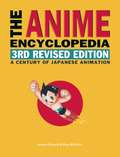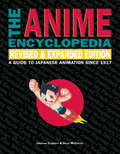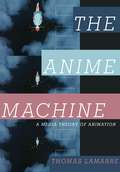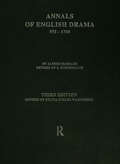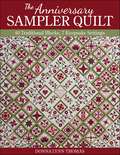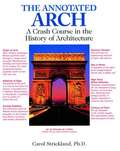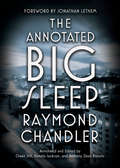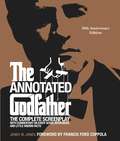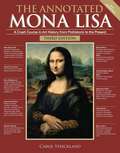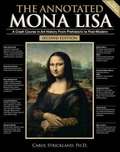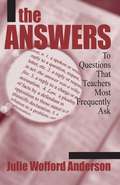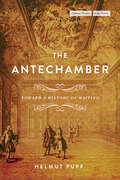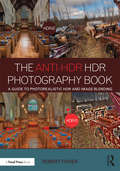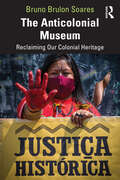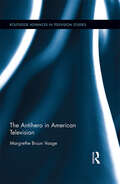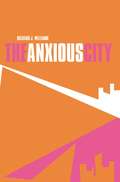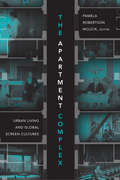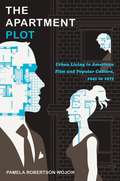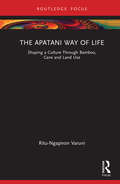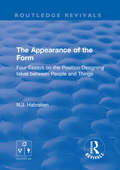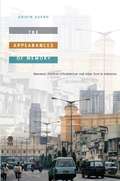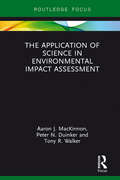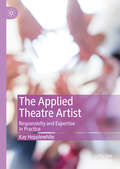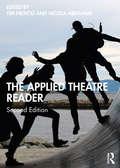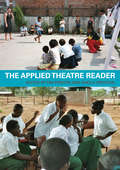- Table View
- List View
The Anime Encyclopedia, 3rd Revised Edition
by Jonathan Clements Helen Mccarthy"Impressive, exhaustive, labyrinthine, and obsessive--The Anime Encyclopedia is an astonishing piece of work."--Neil GaimanOver one thousand new entries . . . over four thousand updates . . . over one million words. . .This third edition of the landmark reference work has six additional years of information on Japanese animation, its practitioners and products, plus incisive thematic entries on anime history and culture. With credits, links, cross-references, and content advisories for parents and libraries.Watch for the e-book edition in December 2014, ISBN 9781611729092, $24.95Jonathan Clements has been an editor of Manga Max and a contributing editor of Newtype USA.Helen McCarthy was founding editor of Anime UK and editor of Manga Mania.
The Anime Encyclopedia, Revised & Expanded Edition
by Jonathan Clements Helen MccarthyBigger and better! Our first edition rocked the anime world with its in-depth entries on anime famous and obscure and its superb index/film finder. Now this fantastic book is 40 percent larger--with all-new entries on hundreds of anime released after 2001, updates on older entries, and over fifty thousand words on anime creators (like Tezuka and Otomo) and genres ("Early Anime," "Science Fiction and Robots," etc.). An absolute must-have for every anime shelf!"If I only had space on my overcrowded shelf for one book on anime, this would be it. If I had no space on my shelf I'd select two books at random and drop them into the bin, just to make room-- it's that indispensable."-- Paul Jacques, Anime on DVD"While you may not agree with their opinons on a given anime, they are informative and entertaining, especially when skewering a really bad anime." -- Frames Per Second
The Anime Machine: A Media Theory of Animation
by Thomas LamarreDespite the longevity of animation and its significance within the history of cinema, film theorists have focused on live-action motion pictures and largely ignored hand-drawn and computer-generated movies. Thomas Lamarre contends that the history, techniques, and complex visual language of animation, particularly Japanese animation, demands serious and sustained engagement, and in The Anime Machine he lays the foundation for a new critical theory for reading Japanese animation, showing how anime fundamentally differs from other visual media.The Anime Machine defines the visual characteristics of anime and the meanings generated by those specifically &“animetic&” effects—the multiplanar image, the distributive field of vision, exploded projection, modulation, and other techniques of character animation—through close analysis of major films and television series, studios, animators, and directors, as well as Japanese theories of animation. Lamarre first addresses the technology of anime: the cells on which the images are drawn, the animation stand at which the animator works, the layers of drawings in a frame, the techniques of drawing and blurring lines, how characters are made to move. He then examines foundational works of anime, including the films and television series of Miyazaki Hayao and Anno Hideaki, the multimedia art of Murakami Takashi, and CLAMP&’s manga and anime adaptations, to illuminate the profound connections between animators, characters, spectators, and technology.Working at the intersection of the philosophy of technology and the history of thought, Lamarre explores how anime and its related media entail material orientations and demonstrates concretely how the &“animetic machine&” encourages a specific approach to thinking about technology and opens new ways for understanding our place in the technologized world around us.
The Annals of English Drama 975-1700: An Analytical Record Of All Plays, Extant Or Lost, Chronologically Arranged And Indexed By Authors, Titles, Dramatic Companies
by Sylvia Stoler WagonheimAn analytical record of all plays, extinct or lost, chronologically arranged and indexed by authors, titles and dramatic companies.
The Anniversary Sampler Quilt: 40 Traditional Blocks, 7 Keepsake Settings
by Donna Lynn ThomasEvery special occasion deserves a memorable quilt Celebrate any important event in life, from an anniversary or a birthday to a retirement or a memorial, with these 40 beautiful blocks and 7 customizable settings. Created to commemorate the author’s 40th anniversary of falling in love with her husband (and making her first quilt for him!), you can read the story behind each block, then make it personal by stitching in your own memories and using blank blocks for personal dedications. Piece and appliqué the stunning sampler quilt, or pick and choose your blocks and setting to suit your own needs and taste. • Many blocks for lots of options! Stitch the sampler or make a quilt with repeated or selected blocks • Easy-to-follow instructions from an experienced quilter, writer, and teacher • Adjust the blocks and settings to make your quilt unique
The Annotated Arch: A Crash Course in the History of Architecture
by Carol Strickland Amy HandyThe Annotated Arch takes architectural history out of the realm of dreary textbooks into a world of dynamic design, succinct page-length essays and instructive sidebars. These graphic devices heighten the reader's ability to retain an impressive amount of information, even through a cursory reading. Incorporating more than 250 illustrations, The Annotated Arch draws on the very elements of architecture to craft a visual and textual approach to the subject that no ordinary textbook could match. A brief run-through of the book's captions and sidebars provides a mini crash course in the history of architecture. From Stonehenge to the Eiffel Tower, from Flippo Brunelleschi to Frank Lloyd Wright, the language of architecture is clarified in five sections. Everything you always wanted to know about architecture is all right here in The Annotated Arch, which covers architectural wonders from the Stone Age to the Space Age. Presented in a reader-friendly format, this new book enlightens, entertains, and informs with its lively look at architecture. What's the difference between Doric, Corinthian, and Ionic? Within the 192 illustrated pages of The Annotated Arch, readers will learn all about these distinctive styles--and more. From engineering breakthroughs to cultural history, from biographical anecdotes to analyses of corresponding and clashing styles The Annotated Arch covers all the architectural bases. The book breaks new ground with excerpts from interviews conducted by the author with leading contemporary architects. This new Annotated book follows Carol Strickland's first volume on art history, The Annotated Mona Lisa. Peppered with sidebars, The Annotated Arch will appeal to anyone who loves architecture or who simply wants to learn more about it in a painless, enjoyable way. It's a great, educational read.
The Annotated Big Sleep
by Raymond ChandlerThe first fully annotated edition of Raymond Chandler&’s 1939 classic The Big Sleep features hundreds of illuminating notes and images alongside the full text of the novel and is an essential addition to any crime fiction fan&’s library. A masterpiece of noir, Raymond Chandler's The Big Sleep helped to define a genre. Today it remains one of the most celebrated and stylish novels of the twentieth century. This comprehensive, annotated edition offers a fascinating look behind the scenes of the novel, bringing the gritty and seductive world of Chandler's iconic private eye Philip Marlowe to life. The Annotated Big Sleep solidifies the novel&’s position as one of the great works of American fiction and will surprise and enthrall Chandler&’s biggest fans. Including: -Personal letters and source texts -The historical context of Chandler&’s Los Angeles, including maps and images -Film stills and art from the early pulps -An analysis of class, gender, sexuality, and ethnicity in the novel
The Annotated Godfather: 50th Anniversary Edition with the Complete Screenplay, Commentary on Every Scene, Interviews, and Little-Known Facts
by Jenny M. JonesCelebrating the 50th anniversary of The Godfather, this authorized, annotated and illustrated edition of the complete, unedited screenplay includes all the little-known facts, behind-the-scenes intrigue, and first-person reflections from cast and crew members on the making of this landmark film.From its ingenious cinematic innovations and memorable, oft-quoted script to its iconic cast, including Marlon Brando, Al Pacino, Robert Duvall, James Caan, The Godfather is considered by many to be the greatest movie ever made. And yet, the history of its making is so colorful, so chaotic, that one cannot help but marvel at the seemingly insurmountable odds it overcame to become a true cinematic masterpiece, and a film that continues to captivate its audience decades after its release.In this authorized, annotated, and illustrated edition of the complete screenplay, nearly every scene is examined and dissected, including: Fascinating commentary on technical details about the filming and shooting locationsTales from the set, including arguments, accidents, anecdotes and practical jokesProfiles of the actors and stories of how they were castDeleted scenes that never made the final cut, and the goofs and gaffes that didAnd much more!Interviews with former Paramount executives, cast and crew members, and director Francis Ford Coppola, round out the commentary and shed new light on everything you thought you knew about this most influential film. With more than 200 photographs, this a truly unique, collectable keepsake for every Godfather fan.
The Annotated Mona Lisa: A Crash Course In Art History From Prehistoric To Present (Annotated Series #Volume 3)
by John Boswell Carol StricklandIt's a paradox of American culture. Throughout the country, in every major city, art museums stand as our proudest, most venerated public institutions - the world's great art, there for all to see. Yet for many Americans, the world of "Art" remains inaccessible, lost in a fog of jargon and theories that can make the artwork itself seem hopelessly remote. <p><p> The Annotated Mona Lisa demystifies art history. It's a brisk, clearly stated survey, from cave painting to conceptual art, that doesn't talk down to its reader and doesn't assume a prior art education. And, most important, it never bores. Dynamic design, with succinct, page-length essays, frequent sidebars, and abundant color illustrations incorporated into the text, make The Annotated Mona Lisa a browser's delight, as well as an authoritative reference that can be read from cover to cover. <p> Sections on ancient and medieval art emphasize context and historical relevance: What kind of people did it take to build the Egyptian pyramids? How has their work influenced the architecture of today? Sections on Renaissance and Baroque art, the nineteenth century, and the modern era touch on all the major figures of the times, while continuing to explain the cultural context out of which the art evolved. A time line at the beginning of each section ties it all together, noting the significant historical events that shaped the art world and the world at large.
The Annotated Mona Lisa: A Crash Course in Art History From Prehistoric to Post-Modern
by John Boswell Patty Brown Carol Strickland Barbara Cohen Aronica Jan Halper ScagliaLike music, art is a universal language. Although looking at works of art is a pleasurable enough experience, to appreciate them fully requires certain skills and knowledge. " --Carol Strickland, from the introduction to The Annotated Mona Lisa: A Crash Course in Art History from Prehistoric to Post-Modern * This heavily illustrated crash course in art history is revised and updated. This second edition of Carol Strickland's The Annotated Mona Lisa: A Crash Course in Art History from Prehistoric to Post-Modern offers an illustrated tutorial of prehistoric to post-modern art from cave paintings to video art installations to digital and Internet media. * Featuring succinct page-length essays, instructive sidebars, and more than 300 photographs, The Annotated Mona Lisa: A Crash Course in Art History from Prehistoric to Post-Modern takes art history out of the realm of dreary textbooks, demystifies jargon and theory, and makes art accessible-even at a cursory reading. * From Stonehenge to the Guggenheim and from Holbein to Warhol, more than 25,000 years of art is distilled into five sections covering a little more than 200 pages.
The Answers: To Questions That Teachers Most Frequently Ask
by Julie Wofford AndersonJulie Wofford Anderson, teacher and educational consultant, uses her years on the front lines to answer the most commonly asked real-life questions of pre-service as well as first and second-year teachers. Her experience supervising teachers and training student teachers provides her with the unique ability to have field-tested answers ready before the questions are asked!Sample questions include: What can I do to command respect from my students? When am I supposed to do all this stuff and teach as well? What are rubrics exactly? How can I establish good discipline in my classroom? What do I do with unreasonable demands by vocal and difficult parents?This practical "been there, done that" approach to overcoming the most common problems facing new teachers today will save time and effort and put you on the path to success. A must for every new and pre-service teacher in K¬-12.
The Antechamber: Toward a History of Waiting (Cultural Memory in the Present)
by Helmut PuffHelmut Puff invites readers to visit societies and spaces of the past through the lens of a particular temporal modality: waiting. From literature, memoirs, manuals, chronicles, visuals, and other documents, Puff presents a history of waiting anchored in antechambers—interior rooms designated and designed for people to linger. In early modern continental Western Europe, antechambers became standard in the residences of the elites. As a time-space infrastructure these rooms shaped encounters between unequals. By imposing spatial distance and temporal delays, antechambers constituted authority, rank, and power. Puff explores both the logic and the experience of waiting in such formative spaces, showing that time divides as much as it unites, and that far from what people have said about early moderns, they approached living in time with apprehensiveness. Unlike how contemporary society primarily views the temporal dimension, to early modern Europeans time was not an objective force external to the self but something that was tied to acting in time. Divided only by walls and doors, waiters sought out occasions to improve their lot. At other times, they disrupted the scripts accorded them. Situated at the intersection of history, literature, and the history of art and architecture, this wide-ranging study demonstrates that waiting has a history that has much to tell us about social and power relations in the past and present.
The Anti-HDR HDR Photography Book: A Guide to Photorealistic HDR and Image Blending
by Robert FisherThe Anti-HDR HDR Photography Book contains everything you’ll need to know in order to get the best results from your High Dynamic Range images. Designed for those who want to extend the dynamic range in their work, but are frustrated by over-processed and hyper-saturated images, this book proves that HDR techniques are capable of producing photographs that are both stunning and realistic. In addition to helping you choose the right equipment and settings to optimize your shoot for HDR, the book explains how to use post-processing software to create natural-looking photographs, blend source images with layer masks, and establish an efficient workflow. By teaching you to effectively use all the most important tools of HDR, it will expand the scope of your portfolio and allow you to create images that you never thought were possible. Key features include: What to look for when choosing a camera for HDR Description of gear that is important to the HDR photographer How to use the HDR software applications Photomatix and SNS-HDR Pro to achieve natural-looking results Discussion of blending multiple source images using simple masks and techniques An in-depth examination of the use of Luminance Masks for blending and editing bracketed images to a photorealistic composite Guide to workflow, from organizing images on the computer to pre-merge editing of RAW files using both Adobe Lightroom and Adobe Bridge The use of black-and-white in HDR and image-blending, including ways to convert color images to black-and-white
The Anticolonial Museum: Reclaiming Our Colonial Heritage
by Bruno Brulon SoaresThe Anticolonial Museum acknowledges some of the consequences of colonialism in the current work of museums. Looking at museum theory in a critical way, it proposes a radical revision of museums’ rhetoric on decolonisation, as well as their public image and practices. Bringing together a collection of reflections on decolonisation through the observation of museum performance and discourse, the author considers current practices in response to the social claims of marginalised groups and activists. Drawing from a genealogy of decolonial thinking in museology, Brulon Soares identifies the inherent paradoxes reflected in museum work. The book’s focus is not exclusively on the reality of colonised countries, nor on the context of former imperialist nations—instead, it raises anticolonial questions, finding common ground between the different actors involved in the museum: scholars, students, curators, practitioners, community members and Indigenous creators. One of the central aims of this book is to view the museum as a locus for multiple enunciations, thus identifying in museum practice the active possibility of reconnecting subjectivities and restoring material fluxes to effectively repair the bonds that have been frayed by colonialism and an expanding modernity. The Anticolonial Museum will be of great interest to researchers and students engaged in the study of decolonisation. It will also be essential for practitioners who wish to reconsider the impact of coloniality on their own position and everyday practice.
The Antihero in American Television (Routledge Advances in Television Studies)
by Margrethe Bruun VaageThe antihero prevails in recent American drama television series. Characters such as mobster kingpin Tony Soprano (The Sopranos), meth cook and gangster-in-the-making Walter White (Breaking Bad) and serial killer Dexter Morgan (Dexter) are not morally good, so how do these television series make us engage in these morally bad main characters? And what does this tell us about our moral psychological make-up, and more specifically, about the moral psychology of fiction? Vaage argues that the fictional status of these series deactivates rational, deliberate moral evaluation, making the spectator rely on moral emotions and intuitions that are relatively easy to manipulate with narrative strategies. Nevertheless, she also argues that these series regularly encourage reactivation of deliberate, moral evaluation. In so doing, these fictional series can teach us something about ourselves as moral beings—what our moral intuitions and emotions are, and how these might differ from deliberate, moral evaluation.
The Anxious City: British Urbanism in the late 20th Century
by Richard J. WilliamsIn the Western world, cities have arguably never been more anxious: practical anxieties about personal safety and metaphysical anxieties about the uncertain place of the city in culture are the small change of journalism and political debate. Cities have long been regarded as problems, in need of drastic solutions. In this context, the contemporary revival of city centres is remarkable. But in a culture that largely fears the urban, how can the contemporary city be imagined? How is it supposed to be used or inhabited? What does it mean? Taking England since WWII as its principal focus, this provocative and original book considers the Western city at a critical moment in its history.
The Apartment Complex: Urban Living and Global Screen Cultures
by Pamela Robertson WojcikFrom the bachelor pad that Jack Lemmon's C. C. Baxter loans out to his superiors in Billy Wilder's The Apartment (1960) to the crumbling tenement in a dystopian Taipei in Tsai Ming-liang's The Hole (1998), the apartment in films and television series is often more than just a setting: it can motivate or shape the narrative in key ways. Such works belong to a critical genre identified by Pamela Robertson Wojcik as the apartment plot, which comprises specific thematic, visual, and narrative conventions that explore modern urbanism's various forms and possibilities. In The Apartment Complex a diverse group of international scholars discuss the apartment plot in a global context, examining films made both within and beyond the Hollywood studios. The contributors consider the apartment plot's intersections with film noir, horror, comedy, and the musical, addressing how different national or historical contexts modify the apartment plot and how the genre's framework allows us to rethink the work of auteurs and identify productive connections and tensions between otherwise disparate texts. Contributors. Steven Cohan, Michael DeAngelis, Veronica Fitzpatrick, Annamarie Jagose, Paula J. Massood, Joe McElhaney, Merrill Schleier, Lee Wallace, Pamela Robertson Wojcik
The Apartment Plot: Urban Living in American Film and Popular Culture, 1945 to 1975
by Pamela Robertson WojcikRethinking the significance of films including Pillow Talk, Rear Window, and The Seven Year Itch, Pamela Robertson Wojcik examines the popularity of the "apartment plot," her term for stories in which the apartment functions as a central narrative device. From the baby boom years into the 1970s, the apartment plot was not only key to films; it also surfaced in TV shows, Broadway plays, literature, and comic strips, from The Honeymooners and The Mary Tyler Moore Show to Subways are for Sleeping and Apartment 3-G. By identifying the apartment plot as a film genre, Wojcik reveals affinities between movies generally viewed as belonging to such distinct genres as film noir, romantic comedy, and melodrama. She analyzes the apartment plot as part of a mid-twentieth-century urban discourse, showing how it offers a vision of home centered on values of community, visibility, contact, mobility, impermanence, and porousness that contrasts with views of home as private, stable, and family-based. Wojcik suggests that the apartment plot presents a philosophy of urbanism related to the theories of Jane Jacobs and Henri Lefebvre. Urban apartments were important spaces for negotiating gender, sexuality, race, and class in mid-twentieth-century America.
The Apatani Way of Life: Shaping a Culture Through Bamboo, Cane and Land Use
by Ritu VaruniThis book celebrates the heritage of the distinctive Apatani community of the north-eastern Himalayan state of Arunachal Pradesh in India. It explores the fascinating indigenous knowledge of field and forest and a uniquely sustainable and enduring way of life that continues to evolve in the modern context. The book tells the story of how a material culture was shaped around bamboo and cane resources and nurtured by a strong community spirit and spirituality that transcended the human world and maintained an unbroken ethos of conservation through time. It highlights the eco-sensitive lifestyle of this unique community and presents an in-depth analysis of the Apatani tradition of the exemplary use of natural resources. Through this engrossing detailed study, the author observes how bamboo houses are built in three days, fish cultivated in a rice field and a single river used for millennia to feed an entire community. She highlights the triumph of the human spirit in engineering a cultural landscape out of a swamp, and how peaceful co-existence with nature can withstand the trials of time. Part autobiographical and powerfully personal, this book is a primer on sustainable living as practice. It will be of interest to researchers and students of tribal and Himalayan vernacular architecture, traditional bamboo-cane craft, urban ecology and geography, cultural studies, and sustainability. It will also attract general readership while being academically useful for anthropologists, sociologists, botanists, ecologists and environmentalists.
The Appearance of the Form: Four Essays on the Position Designing takes between People and Things (Routledge Revivals)
by N.J. HabrakenOriginally published in 1985 this book explores, in four interwoven essays, the many ways human life and built form interact and the place that professional designing takes in this interaction. Together, the essays touch on a number of ideas: the idea that our position in space relative to the thing we are designing determines the methods we apply when designing it; the idea that designing is about making proposals, and is therefore a social act first of all; and the idea that agreements, consensus and above all conventions shape the act of designing things independent of their creative qualities.
The Appearances of Memory: Mnemonic Practices of Architecture and Urban Form in Indonesia
by Abidin KusnoIn The Appearances of Memory, the Indonesian architectural and urban historian Abidin Kusno explores the connections between the built environment and political consciousness in Indonesia during the colonial and postcolonial eras. Focusing primarily on Jakarta, he describes how perceptions of the past, anxieties about the rapid pace of change in the present, and hopes for the future have been embodied in architecture and urban space at different historical moments. He argues that the built environment serves as a reminder of the practices of the past and an instantiation of the desire to remake oneself within, as well as beyond, one's particular time and place. Addressing developments in Indonesia since the fall of President Suharto's regime in 1998, Kusno delves into such topics as the domestication of traumatic violence and the restoration of order in the urban space, the intense interest in urban history in contemporary Indonesia, and the implications of "superblocks," large urban complexes consisting of residences, offices, shops, and entertainment venues. Moving farther back in time, he examines how Indonesian architects reinvented colonial architectural styles to challenge the political culture of the state, how colonial structures such as railway and commercial buildings created a new, politically charged cognitive map of cities in Java in the early twentieth century, and how the Dutch, in attempting to quell dissent, imposed a distinctive urban visual order in the 1930s. Finally, the present and the past meet in his long-term considerations of how Java has responded to the global flow of Islamic architecture, and how the meanings of Indonesian gatehouses have changed and persisted over time. The Appearances of Memory is a pioneering look at the roles of architecture and urban development in Indonesia's ongoing efforts to move forward.
The Application of Science in Environmental Impact Assessment (Routledge Focus on Environment and Sustainability)
by Aaron J. MacKinnon Peter N. Duinker Tony R. WalkerThis book charts the history of the application of science in environmental impact assessment (EIA) and provides a conceptual and technical overview of scientific developments associated with EIA since its inception in the early 1970s. The Application of Science in Environmental Impact Assessment begins by defining an appropriate role for science in EIA. From here it goes on to reflect more closely on empirical and deductive biophysical sciences as they relate to well-known stages of the generic EIA process and explores whether scientific theory and practice are at their vanguard in EIA and related applications. Throughout the book the authors reflect on biophysical science as it applies to stages of the EIA process and also consider debates surrounding the role of science as it relates to political and administrative dimensions of EIA. Based on this review, the book concludes that improvements to the quality of science in EIA will rely on the adoption of stronger participatory and collaborative working arrangements. Covering key topics including foundational scientific guidance materials; frameworks for implementing science amid conflict and uncertainty; and emerging ecological concepts, this book will be of great interest to students, scholars and practitioners of EIA.
The Applied Theatre Artist: Responsivity and Expertise in Practice
by Kay HepplewhiteThis book analyses the work of applied theatre practitioners using a new framework of ‘responsivity’ to make visible their unique expertise. In-depth investigation of practice combines with theorisation to provide a fresh view of the work of artists and facilitators. Case studies are drawn from community contexts: with women, mental health service users, refugees, adults with a learning disability, older people in care, and young people in school. Common skills and qualities are given a vocabulary to help define applied theatre work, such as awareness, anticipation, adaptation, attunement, and responsiveness. The Applied Theatre Artist is of scholarly, practical, and educational interest. The book offers detailed analysis of how skilled theatre artists make in-action decisions within socially engaged participatory projects. Rich description of in-session activity reveals what workshop facilitators actually do and how they think, offering a rare focus in applied theatre.
The Applied Theatre Reader
by Prentki, Tim / Abraham, NicolaThe Applied Theatre Reader is the first book to bring together new case studies of practice by leading practitioners and academics in the field and beyond, with classic source texts from writers such as Noam Chomsky, bell hooks, Mikhail Bakhtin, Augusto Boal and Chantal Mouffe. This new edition brings the field fully up to date with the breadth of applied theatre practice in the twenty-first century, adding essays on playback theatre, digital technology, work with indigenous practitioners, inter-generational practice, school projects and contributors from South America, Australia and New Zealand. The Reader divides the field into key themes, inviting critical interrogation of issues in applied theatre whilst also acknowledging the multi-disciplinary nature of its subject, crossing fields like theatre in educational settings, prison theatre, community performance, theatre in conflict resolution, interventionist theatre and theatre for development. A new lexicon of Applied Theatre and further reading for every part will equip readers with the ideal tools for studying this broad and varied field. This collection of critical thought and practice is essential to those studying or participating in the performing arts as a means for positive change.
The Applied Theatre Reader
by Tim Prentki Sheila PrestonThe Applied Theatre Reader is the first book to bring together new case studies of practice by leading practitioners and academics in the field and beyond, with classic source texts from writers such as Noam Chomsky, bell hooks, Mikhail Bakhtin, Augusto Boal, and Chantal Mouffe. This book divides the field into key themes, inviting critical interrogation of issues in applied theatre whilst also acknowledging the multi-disciplinary nature of its subject. It crosses fields such as: theatre in educational settings prison theatre community performance theatre in conflict resolution and reconciliation interventionist theatre theatre for development. This collection of critical thought and practice is essential to those studying or participating in the performing arts as a means for positive change.
